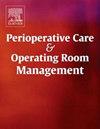评价前深层锯肌和胸骨旁浅层联合阻滞对保留乳头乳房切除术术后预后的影响:一项回顾性的探索性研究
IF 1
Q2 Nursing
Perioperative Care and Operating Room Management
Pub Date : 2025-07-16
DOI:10.1016/j.pcorm.2025.100527
引用次数: 0
摘要
背景:单中心、回顾性和探索性研究。我们评估了深度锯肌前平面阻滞(dSAPB)和浅表胸骨旁阻滞(sPSB)联合治疗全麻(GA)下保留乳头乳房切除术(NSM)伴皮肤扩张器置入患者术后疼痛的有效性。我们分析了与术后疼痛、抢救剂量、术后早期活动和术后恶心呕吐(PONV)的关系。方法纳入计划择期行皮肤扩张器植入术的患者。将GA前进行区域麻醉(dSAPB+sPSB)的患者与标准护理(SoC,吗啡加酮罗拉酸术后疼痛管理)组进行比较。我们对分类变量使用卡方检验,对连续变量使用学生t检验或Mann-Whitney检验来检验差异。为了评估麻醉管理与结局(术后24小时疼痛、抢救剂量[酮洛拉酸30 mg]、PONV和早期活动)之间的关系,我们进行了单变量logistic回归。计算95%置信区间(ci95%)的优势比(OR)。所有检验采用α=0.05。p值<;0.05被认为具有统计学意义。结果对31例患者进行分析。区域组患者(19例)报告最严重NRS中位数显著降低(P = 0.0076),报告中度疼痛的患者比例较低(NRS 4-6, 5.3%, SoC为50.0%,- 44.7%,CI95 % -81.5- - 7.9%, P = 0.0132)。区域麻醉显著减少了术后疼痛的发生(OR 0.18, CI95 % 0.03-0.81, P = 0.0321)和抢救剂量的需要(OR 0.19, CI95 % 0.03-0.89, P = 0.0412)。结论与SoC相比,dSAPB+sPSB联合应用可改善术后疼痛控制。然而,由于有限的样本量和回顾性设计,这些发现应被视为初步和假设生成。需要进一步的研究来确定这种方法是否对PONV、早期动员和LOS有影响。本文章由计算机程序翻译,如有差异,请以英文原文为准。
Evaluating the impact of combined deep serratus anterior and superficial parasternal blocks on postoperative outcomes in nipple-sparing mastectomy: A retrospective, exploratory study
Background
Single-centre, retrospective, and exploratory study. We evaluated the effectiveness of combining the deep serratus anterior plane block (dSAPB) and superficial parasternal block (sPSB) for managing postoperative pain in patients undergoing nipple-sparing mastectomy (NSM) with skin expander placement under general anesthesia (GA). We analyzed the relationships with postoperative pain, the need for rescue doses, early postoperative mobilization, and postoperative nausea and vomiting (PONV).
Methods
We included patients scheduled for elective NSM with skin expander placement. Patients performed regional anesthesia (dSAPB+sPSB before GA) were compared vs. standard of care (SoC, post-operative pain management with morphine plus ketorolac) group. We tested differences using the Chi-square test for categorical variables and Student's t-test or Mann-Whitney test for continuous variables. To evaluate the relationships between anesthesiologic management and outcomes (24 h postoperative pain, rescue dose administration [ketorolac 30 mg], PONV, and early mobilization), we performed univariate logistic regression. Odds ratios (OR) with 95 % confidence intervals (CI95 %) were computed. All tests were conducted with α=0.05. A p-value <0.05 was considered statistically significant.
Results
The analysis was based on 31 patients. Patients in the regional group (19 patients) reported a significant reduction in the median of worst NRS (P = 0.0076), with a low percentage of patients reporting moderate pain (NRS 4–6, 5.3 % vs 50.0 % for SoC, -44.7 %, CI95 % -81.5- -7.9 %, P = 0.0132). Regional anesthesia significantly reduced the development of postoperative pain (OR 0.18, CI95 % 0.03–0.81, P = 0.0321) and the need for rescue doses (OR 0.19, CI95 % 0.03–0.89, P = 0.0412).
Conclusion
The combination of dSAPB+sPSB appeared to provide improved postoperative pain control compared to SoC. However, due to the limited sample size and retrospective design, these findings should be considered preliminary and hypothesis-generating. Further studies are warranted to determine whether this approach has an impact on PONV, early mobilization, and LOS.
求助全文
通过发布文献求助,成功后即可免费获取论文全文。
去求助
来源期刊

Perioperative Care and Operating Room Management
Nursing-Medical and Surgical Nursing
CiteScore
1.30
自引率
0.00%
发文量
52
审稿时长
56 days
期刊介绍:
The objective of this new online journal is to serve as a multidisciplinary, peer-reviewed source of information related to the administrative, economic, operational, safety, and quality aspects of the ambulatory and in-patient operating room and interventional procedural processes. The journal will provide high-quality information and research findings on operational and system-based approaches to ensure safe, coordinated, and high-value periprocedural care. With the current focus on value in health care it is essential that there is a venue for researchers to publish articles on quality improvement process initiatives, process flow modeling, information management, efficient design, cost improvement, use of novel technologies, and management.
 求助内容:
求助内容: 应助结果提醒方式:
应助结果提醒方式:


